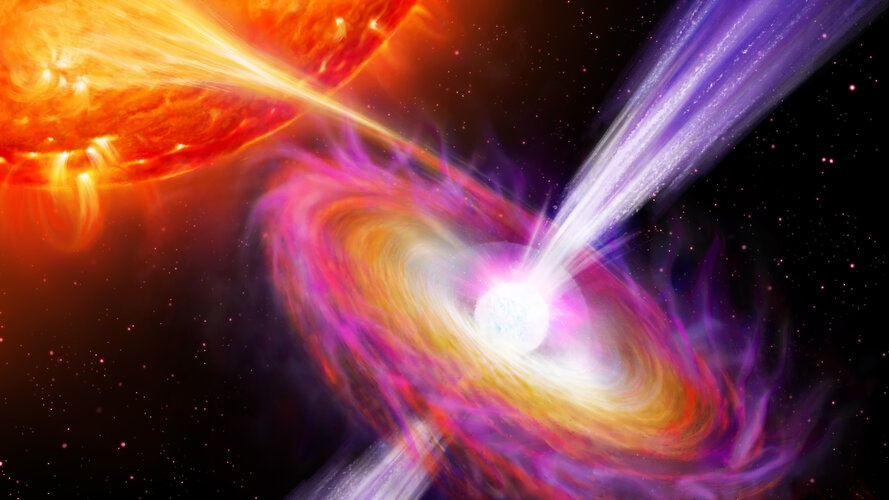It’s a well known fact that black holes absorb anything that falls into them. Often before material ‘vanishes’ inside it forms into an accretion disk around them. Like the progenitor stars, the black holes have powerful magnetic fields and these can generate jets that blast away from the black hole. A similar process occurs in neutron stars that are orbiting other stars and recent observations holes have shown that some material in the jets travel at speeds 35-40% the speed of light.
The European Space Agency launched the International Gamma Ray Astrophysics Laboratory (Integral) in October 2002. Its purpose to observe gamma ray events across the universe with energies up to 8 MeV (meagaelectron volts). Not only can it image gamma ray events, it can also provide spectroscopic analysis. Of all the gamma ray instruments in space, Integral is the most sensitive. It was using Integral that astronomers detected the high velocity jets.

One of the chief methods used to identify the velocity of jets is to track matter moving along their length. This might sound easy but the distances to them are so extreme that observing their movement is difficult. A team of astronomers led by Thomas Russell from the National Institute for Astrophysics in Italy conjured up a cunning idea that neutron stars might help!
Neutron stars are the result of the collapse of a massive star – effectively they are a whacking great neutron often around the size of Earth – and when a neutron star orbits another star, it can strip material off the companion. Most of the material accretes on the neutron star surface and wen it reaches a critical mass, a nuclear explosion occurs in an event known as a type-I x-ray burst. Some material however escapes this event by being ejected out of jets along the star’s rotational axis.
Russell and his team concluded that the matter would be accelerated by the energy from the neutron star surface and it may be possible to measure the disturbance. The short lived impulse of extra material shot along the beam may make it easier to track. To date, there are 125 neutron stars that behave like this. If sufficient neutron stars with jets can be observed hen it may help us to understand the primary launching mechanism and whether magnetic fields from the star or material are key.
Two neutron stars (4U 1728-34 and 4U 1636-536) have been shown to exhibit x-ray burst events but only ’34 could be observed in radio wavelengths. x-ray events were observed on ‘536 but they only emitted radio waves. Supporting observations were needed from radio telescopes around the world. The bursts usually occur every few hours but it is difficult to predict. The Australian Telescope Compact Array chocked up 30 hours of observing in April 2021 and captured 14 x-ray bursts. The team were surprised to see that the nuclear explosion did not destroy the location where the jet launched but instead, saw strong input. The jets are well established phenomenon capable of withstanding such events.
The new technique has shown that neutron star jets can be observed in this way so further observations are required to further explore the fascinating phenomena.
Source : Integral spots giant explosions feeding neutron star jets?

